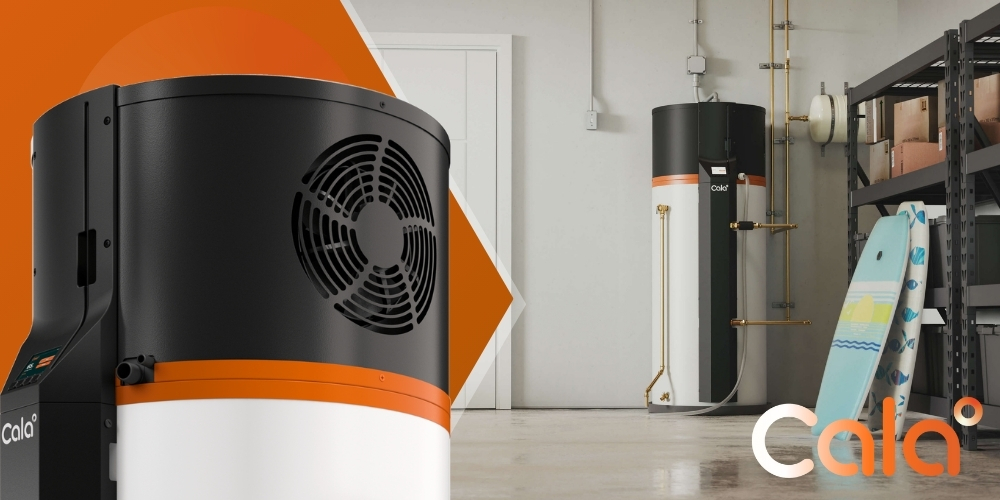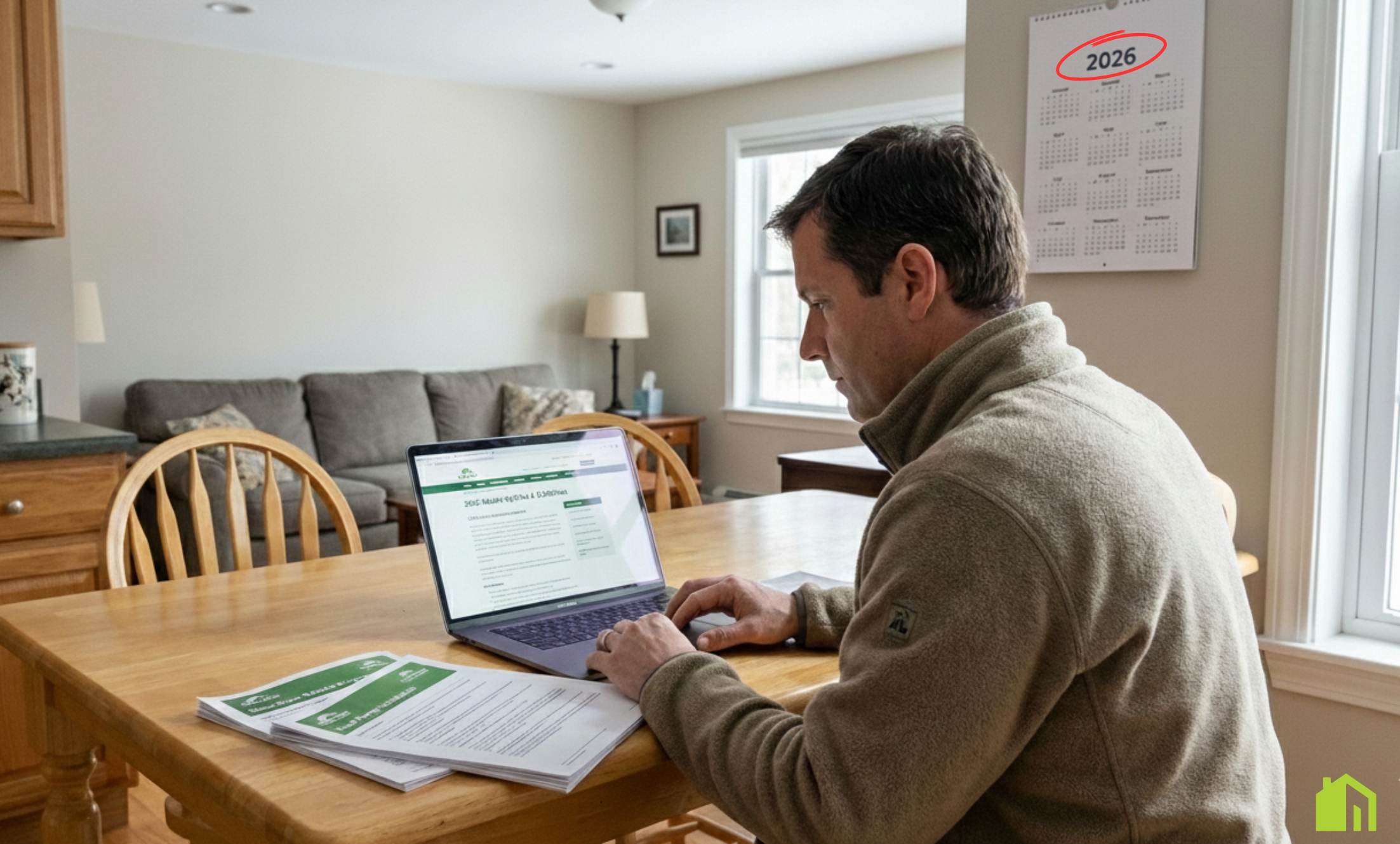How to Tell If the Problem Is Your Thermostat or HVAC System

Intelligent Heat Pump Water Heaters for Massachusetts Residential Homes — Why SumZero Selects Cala
By SumZero Energy Systems — Massachusetts’ #1 Heat Pump Installation Team
Picking a new water heater once involved a simple decision between gas and standard old electric, praying the hot water wouldn't be gone when there were two showers in a row. That's no longer the case. Now, the ideal solution for the majority of Massachusetts homes is a smart heat pump water heater (HPWH). This isn't the typical hybrid of which you might have heard, but a rather new breed of unit that adapts to your home's schedule, accommodates your energy usage, and maintains comfort consistently while consuming a lot less energy.
When homeowners want to have it exactly right the first time, our team is discerning about what products we choose. We consider the landscape and inspect the details before determining that they might work with Cala, a company that produces a high-technology hot water heater that modern homes need: intelligent, consistent, and efficient hot water — installed properly. This article describes why this alliance matters, how the tech benefits your home, what you should expect from our installation, and the handy information (rebates, credits, fit questions) homeowners inquire about daily.
Why This Alliance Is Important
(and What It Does for You)
There are two parts to a successful hot water solution:
Great technology
A system that makes you comfortable and uses less energy.
Great installation
Design, placement, airflow, electrical, condensate handling, commissioning, and long-term support.
Cala provides a tailor-built, smart HPWH platform. SumZero provides actual-world experience so that it works perfectly in real Massachusetts homes.
Together, we provide three things homeowners report wanting:
Accurate hot water at peak periods without guessing.
Cheaper monthly energy bills without compromise on comfort.
It is a future-proof solution that addresses the trend towards greener, all-electric homes.
Simply put: We get hot water. We know how to properly install heat pump technology. This combination makes a water heater upgrade a smart, long-term decision.
The Homeowner's Dilemma That We Are
If you have had a gas or a typical electric water heater, then you know the problems:
Hot-cold swings on hectic morning routines.
Higher electricity bills than hoped for.
No real insight, no real control.
A replace cycle that is experienced as "buying the same thing again."
Typical hybrid: Heat pump water heaters perform better, yet they still react: They delay until the tank cools off, then warm it up again. Homeowners averred they desire a system which thinks ahead—a unit which is a breeze to operate, handles peak load graciously, and does not make them compromise.
They fill that gap, which is why we work with them.

Why a Smart HPWH is Different
A standard electric water heater makes heat by passing an electric element, a giant toaster coil, through the tank. A heat pump water heater does it another way: it takes heat from the air it lives in and puts it into the water. Because it costs less energy to move heat than create it, heat pump water heaters run on much less power than typical electric ones. And they avoid burning gas, venting, and pollution.
A smart HPWH goes one step further:
It adapts to your home's schedule (morning showers, nighttime laundry) and preheats when demand isn't yet high.
You can use the app to check, plan, or increase hot water whenever you want.
It has a compressor that can change speed to fit what you need (not just "on/off").
It is achievable with a mixing valve holding water at the proper warmth for improved efficiency and then providing a sustained, safe warmth for usage. This is also possible with the availability of additional warm water at peak usage times.
It goes nicely with a contemporary home — primed for solar, time-of-use, and information you can view at a glance.
Result: more stable comfort, less energy use, improved control.
Why a Smart HPWH is Different
From what is visible on-site, there are three things certain for homeowners regarding the points of Cala:
1) Ease That Is Effortless
Consistent hot water at peak use is the ultimate test. Through forecasting demand and using a mixing valve, Cala maintains a steady supply. That results in less "uh oh" when two showers coincidentally happen at once or someone turns on the dishwasher.
2) Controls That You'll Ever Use
App functionality is key when done properly. You can check if there's hot water, turn up the heat for guests, view energy usage history, or simply set it and leave. As installers, we appreciate performance data — it allows us to address little issues before large ones form.
3) Future-Ready from Day One
Massachusetts is going towards clean, electricity-based homes. Cala's strategy combines well: it is scalable for solar power and accounts for time-of-use rates when needed. If you foresee solar energy at some time, or already have it, this water heater won't stop your home from being efficient.
4) A Company That Stands Behind Its Product
Cala backs every unit with a 10-year parts warranty and 3-year labor warranty — a strong sign they stand behind both the technology and the people who install it. At SumZero, we respect that kind of commitment because it mirrors our own approach: taking care of homeowners and supporting our partners with the same level of trust and accountability.
What SumZero Offers As Your Installer
(Why It Matters)
Even the best system won't work so great if installed wrong. Our task is getting your new HPWH working perfectly inside your home, not on a drawing board. This is what our approach is:
Right-size design.
We measure how much water your home needs and discuss the high-flow fixtures, filling bathtubs, and washer usage.
Best installation and ventilation.
HPWHs require air to make the heat move. We consider the room size, doors, vents, and — when necessary — ducting solutions for high performance and low noise.
Clean handling of electricity and condensate.
Safe power, tidy routing, and a trustworthy drainage plan are essential.
Commissioning correctly.
We don't just "turn it on." We verify performance, position the mixing valve, help you with the app, and verify your comfort objectives.
Rebates, credits, and financial assistance.
Mass Save, federal 25C, and the 0% HEAT Loan (if applicable) — we'll help you with that.
We take special care.
Our teams respect your home, protect your floors, and leave the place nicer than they found it.
Aftercare you can count on. Questions years down the road? We're here. The whole concept of a smart system is long-term confidence, not a one-day installation.
Costs, Incentives, and Lifetime Value
Two parts matter here: upfront cost and operating cost.
→ It is a better unit than a standard electric or simple hybrid. Tax credits and rebates make a big difference. A lot of Massachusetts homeowners rely on the 0% HEAT Loan for easier payments.
→ Month after month, the intelligent HPWH's effectiveness is where the value lies. By transferring (not creating) heat and by scheduling heating intelligently, homeowners consistently experience significant decreases in water-heating energy consumption — particularly relative to resistance electric, and many times relative to gas or delivered fuels when full costs are factors.
If you'd like figures specific to your home (household number, showering usage, energy costs), we'll do the math at your consult and provide you with a clear estimate of payback, lifetime cost saving, and the rebates for which you qualify.
Are Smarter Heat Pump Water Heaters Good for Your Home?
It is feasible for many Massachusetts homes. We will cover:
→ Household size and routines. Families with up to about 5 people usually do well with the standard setup; we will give advice for larger families or special situations.
→ Space and ventilation. We check the space, door vents, or ducts if necessary, and ventilation so the system operates properly.
→ Location. Basements are typical, as are utility rooms. As the unit functions, it removes air that feels like a dehumidifier — a typical plus for basements.
→ Electrical. We check panel capacity and proper wiring; no installation day surprises.
→ Future plans. Now or in the future for solar? Time-of-use rates? We'll put the system on so it grows with your home.
[[cta-heatpump]]
Why Is Cala Different from "Traditional Hybrids"?
✪ Control and Convenience:
Cala integrates intelligent tech with a mixing valve to remain comfortable, even when it is busy. Most standard hybrid units have simple modes and react only when the tank becomes chilled.
✪ Care and Trust:
Performance insights help you recognize problems early on and keep you on your feet for surprises. Traditional deployments are mostly "wait and see."
✪ Timing and Efficiency:
Variable driving and improved scheduling assist in energy saving with the maintenance of comfort. Ordinary hybrids operate more often and at undesirable times.
✪ Future-Ready
The design of the Cala accommodates with solar power, intelligent homes, and plans for utilizing electricity. Most older hybrids were not built for that usage.

What to Expect with SumZero
(From the First Call Through the First Shower)
✪ Talk & Pictures
We'll first glance at your objectives and take some fast photos of the current installation: the water heating unit, panel, and surrounding room.
✪ Right-Fit Design
We fit your hot water consumption and available spaces to a design which we endorse.
✪ Chaplain: A Comprehensive
Your quote is going to be transparent, includes information for installation, accessories, and a checklist for incentives. The paperwork assistance takes care of our end.
✪ Professional Installation
Licensed, insured, and detail-orientated. We dispose of the old unit, prepare the site, install and commission a new system, and leave the site tidy.
✪ App Introduction and Instructions
You'll discover how to see hot water supply, schedule increases, and view consumption — without being "technical."
✪ Support and Help
We're your long-term partner. Got a question? You call us — that's what homeowners deserve from the #1 heat pump installation company.
Common Questions We Get
(And Easy Answers)
Smart heat pump water heaters move heat from the surrounding air into the water instead of generating heat directly. This makes them up to three to four times more efficient than standard electric models. Cala’s intelligent system takes it further — it learns your household’s patterns, preheats before busy periods, and gives you app-based control to monitor or boost hot water anytime.
Most hybrid water heaters react when the tank cools. Cala predicts when your home will need hot water and heats proactively, saving more energy while maintaining comfort. It also features a variable-speed compressor, integrated mixing valve, and performance monitoring portal, giving both homeowners and installers a smarter, more reliable experience.
Savings depend on your energy source and usage, but many Massachusetts homeowners cut their water-heating costs by 50–70% when switching to a heat pump system. Cala’s intelligent controls add even greater efficiency. Add Mass Save® rebates, federal 25C tax credits, and potential 0% HEAT Loan financing, and most families see real payback within just a few years.
Yes — most Massachusetts homes are a great fit. Cala’s 65-gallon design comfortably serves households up to five people and can prepare up to 90 gallons ahead of peak use. The system needs adequate space and airflow, similar to a dehumidifier, and our team at SumZero handles every detail — from placement and ducting to electrical and performance checks.
SumZero Energy Systems is Massachusetts’ #1 heat pump installation team, trusted for precision, transparency, and high-quality service. We manage every step — design, installation, rebate paperwork, app setup, and long-term maintenance — so homeowners enjoy smarter comfort and lasting confidence. With SumZero, you’re not just buying equipment; you’re gaining a partner who stands behind it.
Why We Feel Secure Recommending This to Massachusetts Homeowners
We have a simple promise: we only install solutions that we would use in our own homes. Cala’s approach — being smart, having control, and being ready for the future — matches what we have learned from many talks with homeowners in the state. Together with SumZero’s careful installation standards and ongoing support, this water-heating upgrade makes sense right away and will last well with your home. Cleaner heat. Smarter comfort. Fewer bills.
Ready to Take the Next Step?

To learn more about Cala’s technology and vision, visit Cala Systems.
How to Tell If the Problem Is Your Thermostat or HVAC System
When your home suddenly feels too warm or too cold, it’s easy to assume something major is wrong with your heating or cooling system. But before jumping to conclusions and worrying about expensive repairs, it's worth taking a closer look at your thermostat. For many Massachusetts homeowners, understanding the difference between a faulty thermostat and a full-blown HVAC issue can save both time and money.
Spotting where the problem starts can help you make more informed decisions—and may even point to an easy fix you hadn’t considered. In this guide, we’ll walk you through the key signs of thermostat-related issues and what they look like compared to larger HVAC problems.
Common Thermostat Repair Signs You Should Know
A thermostat may seem like a simple device, but it plays the crucial role of communicating with your HVAC system. When it’s not working correctly, the entire system's performance can suffer.
How to Tell If You Need Thermostat Repair
There are clear signs that something's not quite right with your thermostat. Here’s what to look for:
- Temperature doesn't match settings: If your thermostat says 72 degrees but your rooms feel way off, something’s misfiring.
- No response when changing settings: Adjusting the temperature should kick your system on within a few minutes. If nothing happens, that could point to a faulty connection.
- Short-cycling: When the HVAC turns on and off in rapid bursts, it often means your thermostat is sending mixed signals.
- Blank or unlit display: If your thermostat screen is dark or frozen, it may not be sending any commands at all.
- Different temperatures in different rooms: Persistent inconsistencies can mean the thermostat isn't reading or communicating accurately.
Many Massachusetts homeowners overlook the thermostat first—yet it's one of the easiest and most affordable HVAC components to repair or replace.
What Causes a Malfunctioning Thermostat?
Thermostat issues can stem from several underlying problems that aren’t always obvious. These include:
- Dead or low batteries (yes, it can really be that simple)
- Loose or aging wires behind the thermostat
- Faulty sensors that misread temperatures
- Software issues in smart thermostats
The good news? In many cases, you can check or fix these on your own, particularly if it's a battery or settings issue.
HVAC or Thermostat: How to Tell Which Needs Attention
It’s not always easy to know where the real problem lies. But there are a few ways to isolate whether the trouble starts at the thermostat—or deeper in the HVAC system itself.
Try This First Before Scheduling HVAC Thermostat Repair
Start with these simple checks. Sometimes, a little troubleshooting can go a long way:
- Change the batteries if your thermostat has them—they might be weak or dead.
- Set the temperature at least 5 degrees higher (for heat) or lower (for cooling) and see if the system kicks in.
- Flip the system OFF then back ON after a few minutes, allowing the internal circuits to reset.
- Clean off any visible dust from your thermostat’s sensors and housing.
- Make sure your home’s circuit breaker hasn’t tripped.
More than 30% of HVAC service calls could be avoided with simple fixes like checking batteries or resetting the thermostat.
If your system still doesn’t respond after basic checks, the issue might be in the HVAC hardware itself—like the furnace, air handler, or heat pump.
Signs the HVAC System Could Be the Culprit
Watch for these indicators that point to the problem lying beyond the thermostat:
- System starts up but doesn't blow hot or cold air
- New, unusual noises like grinding, whining, or clunking
- Airflow is weak or nonexistent from multiple vents
- System seems stuck on one setting and won’t turn off
- Unexplained spike in your energy bills month-over-month
In these cases, the thermostat is likely doing its job correctly—but the heating or cooling system is failing to respond. That’s when it’s time to look deeper into repairs or diagnostics for the equipment.
[[cta-heatpump]]
Saving on Thermostat Repair Cost in Massachusetts
Like anything in your home, repairing or replacing a thermostat comes with its own costs—but you may be pleasantly surprised. In many cases, repair is affordable, especially when caught early.
Average Thermostat Repair Cost for Local Homeowners
In Massachusetts, these are typical price ranges you might see:
- Standard thermostat repair: $75–$200 depending on the issue
- Smart thermostat repair: $100–$300 depending on make and features
- Replacement: Ranges between $150–$500, including installation
Smart thermostats from brands like Mitsubishi Electric or Bosch HVAC may carry a higher initial cost, but often provide savings over time through energy efficiency and smart scheduling features.
According to Mass Save®, Massachusetts homeowners can qualify for rebates when upgrading to qualifying energy-efficient thermostats or HVAC systems.
Ways to Cut Down on Thermostat Costs
To save money on repairs and replacements right here in Massachusetts, consider these tips:
- Take advantage of Mass Save® rebates and incentives
- Install a programmable or smart thermostat to better manage heating and cooling
- Bundle replacement with existing HVAC upgrades if your system is already being serviced
- Ask about warranties on parts and labor to reduce long-term expenses
- Opt for models that are compatible with your current HVAC system to avoid extra installation tweaks
These steps not only help reduce your immediate thermostat repair cost, but also improve your home's long-term energy management.
What if You Need to Fix Thermostat Issues Repeatedly?
If you find yourself adjusting the thermostat constantly, resetting it often, or replacing it every couple of years, you may be missing a bigger issue—like a mismatch between the HVAC system and the control device itself.
In such cases:
- Upgrade to a smart thermostat that learns usage patterns
- Make sure all components (including wiring) are compatible
- Ensure software updates are enabled if using digital or WiFi-powered thermostats
- Evaluate whether your system’s power load and response time are aligned with the thermostat you’re using
Consistent performance matters—especially during unpredictable New England weather. A reliable thermostat helps your HVAC do its job better during those freezing Massachusetts winters and sticky summers.
Final Thoughts: Solving the Thermostat vs. HVAC Puzzle
If your thermostat is not working, don’t panic. Start with simple checks like battery replacement or resetting your unit. Only when those fail should you consider broader hvac thermostat repair. Understanding the root cause—whether it’s a communication issue or something deeper—can help you avoid unnecessary expenses and get your home back to the perfect temperature faster.
Massachusetts homeowners can stay one step ahead by regularly maintaining HVAC systems, checking thermostats seasonally, and exploring savings programs like those offered by Mass Save®. Taking these simple steps means more comfort, better energy use, and fewer surprises on your utility bills.
By staying informed, you’ll know when it’s time to fix your thermostat—and when it's time to dig deeper.
Don’t sweat it—our thermostat repair services help you bring balance back to your home’s temperature. Get fast, affordable fixes from trusted Massachusetts experts today!
Schedule Thermostat RepairYou Might Also Like…
Continue learning with handpicked articles that inform and inspire.
Not Sure Where to Start? We’ll Guide You
Let our experts design the right heating and cooling solution—customized for your comfort, your layout, and your energy goals. No pressure. Just clarity.
Request FREE ESTIMATE









